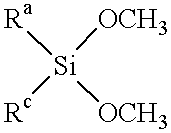Olefin polymerization catalyst and process for preparing polypropylene and propylene block copolymer
a technology of olefin polymerization and polypropylene, which is applied in the direction of bulk chemical production, etc., can solve the problems of large amount of hydrogen giving rise to problems, limited use, and insufficient rigidity of propylene polymers obtained by prior art techniques, and achieves easy regulation of melt flow rate. , the effect of reducing the amount of hydrogen
- Summary
- Abstract
- Description
- Claims
- Application Information
AI Technical Summary
Benefits of technology
Problems solved by technology
Method used
Image
Examples
example 2
Preparation of Homopolypropylene
Into a 17-liter autoclave were introduced 3 kg of propylene and 20 liters of hydrogen, and the temperature of the system was raised to 60.degree. C. Then, 15 mmol of triethylaluminum, 15 mmol of IPAMP and 0.05 mmol (in terms of titanium atom) of the prepolymerized catalyst [I] obtained in Example 1 were added to the autoclave. The temperature of the system was raised to 70.degree. C., and the same temperature was kept for 50 minutes to perform homopolymerization of propylene.
The results are shown in Table 1.
example 3
Preparation of Homopolypropylene
Homopolymerization of propylene was carried out in the same manner as in Example 2 except that hydrogen was added in an amount of 8 liters.
The results are shown in Table 1.
example 4
Preparation of Propylene Block Copolymer
Into a 17-liter autoclave were introduced 3 kg of propylene and 50 liters of hydrogen, and the temperature of the system was raised to 60.degree. C. Then, 15 mmol of triethylaluminum, 15 mmol of IPAMP and 0.05 mmol (in terms of titanium atom) of the prepolymerized catalyst [I] obtained in Example 1 were added to the autoclave. The temperature of the system was raised to 70.degree. C., and the same temperature was kept for 40 minutes to perform homopolymerization of propylene.
After the end of the homopolymerization of propylene, the vent valve was opened to release the autoclave until the pressure reached atmospheric pressure.
After the end of the release of pressure, copolymerization of ethylene and propylene was carried out in the following manner. Ethylene and propylene were fed to the polymerization reactor at rates of 240 Nl / hr and 960 Nl / hr, respectively. The vent was adjusted on its opening degree so that the pressure in t...
PUM
| Property | Measurement | Unit |
|---|---|---|
| polymerization volume | aaaaa | aaaaa |
| temperature | aaaaa | aaaaa |
| molar ratio | aaaaa | aaaaa |
Abstract
Description
Claims
Application Information
 Login to View More
Login to View More - R&D
- Intellectual Property
- Life Sciences
- Materials
- Tech Scout
- Unparalleled Data Quality
- Higher Quality Content
- 60% Fewer Hallucinations
Browse by: Latest US Patents, China's latest patents, Technical Efficacy Thesaurus, Application Domain, Technology Topic, Popular Technical Reports.
© 2025 PatSnap. All rights reserved.Legal|Privacy policy|Modern Slavery Act Transparency Statement|Sitemap|About US| Contact US: help@patsnap.com



